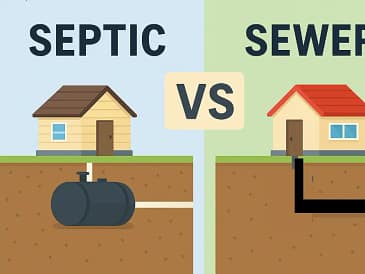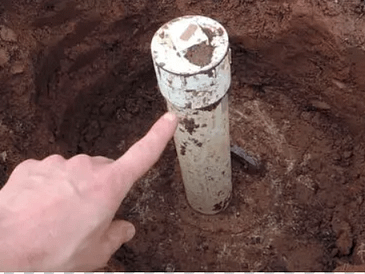If your property contains a septic system, you should know its location. Doing so can help avoid damaging the tank by adding structures or planting deeply-rooted plants near it.
Additionally, investing now will save you money in the long run. Damage to power lines could result in fines or costly repairs later on.
Look for a Map
If you need to locate the exact location of your septic tank, there are several methods. Check your property records; usually, the deed and building permit/design plans will contain details on its presence.
You can also consult municipal records or ask your previous owner where the septic tank is situated. While this will give you a good indication, it may not be precise enough.
Another option is to follow the sewer pipes that exit your home and into your yard. These typically 4-inch metal lines run from your main drains to a septic tank.
To locate these pipes, insert a thin metal probe into the ground near where they leave your house. Insert it every two feet and you should feel it hit a flat concrete or fiberglass surface – this is an indication that you’ve taken the right turn.
Next, search your lawn for any dips or small hills that might indicate a buried septic tank. Many are installed in such a way as not to draw attention, but over time these areas may become hard to distinguish from the rest of your landscaping due to grass growth.
Once you’ve identified these locations, take a walk around your property to search for more clues. These could include raised or sunken areas that indicate a shallow-buried septic tank, as well as areas with lush growth.
It’s wise to keep an eye out for bald spots without grass growth, which could indicate a septic tank beneath your soil. This is especially useful in wintertime when snowmelt acts as an effective indicator of where your septic tank lies.
Finally, consider purchasing an electronic transmitter and flushing it down your toilet to track where the signal is strongest. While this isn’t a guarantee for finding your tank, it could be useful if other clues don’t work.
Follow the Sewer Pipes
If you’re uncertain where your septic tank is, follow the sewer pipes that carry waste from your home to a main sewer main under the street. Usually, this will lead directly to your septic tank.
You can use a map of your house to make this determination. The map will indicate the position of your septic tank, distribution box and absorption field with respect to your home. Having this info handy can be extremely beneficial when performing future maintenance and repair on your system.
Septic systems are underground, closed-system sewage treatment and disposal systems designed for treating wastewater from residential or commercial buildings. The septic tank, drain field and distribution box filter out waste before it’s buried in the soil beneath them.
Your septic tank requires regular maintenance and pumping in order to stay functioning optimally. According to manufacturer instructions, you should have it pumped every 3-5 years for optimal effectiveness.
Septic tanks often become full due to accumulation of solid waste and liquids not broken down by your system, leading to backed-up or slow draining drains in your home.
In some instances, wastewater from your home may build up and blockage in your drain field – located nearby your septic tank. This could be a serious issue if the tank is overfilled as it will prevent the drain field from emptying properly.
Regular pumping of your septic tank is recommended, as this helps prevent the buildup of wastewater that could eventually clog the system and require costly repairs or replacement. Furthermore, avoid using certain types of sanitary materials like diapers or wipes which could clog your septic tank.
If your septic tank is overfilled, you may need to have it pumped or some soil removed so the drain field can empty properly. This usually is a simple and cost-effective procedure.
Another option is having a professional plumber dig up soil to pinpoint where your septic tank will be situated. They can then map out its exact location on a map and install risers for future convenience.
Look for Clues
Many counties maintain records of the installation of septic tanks at each property, and these maps should include schematics that demonstrate its precise placement as well as measurements to help locate it. Remember that landmarks may change over time, so don’t rule out a spot just because there are more shrubs or trees nearby.
If you live in a rural area, chances are your home is serviced by a septic system. If not sure, ask some of your neighbors; if they all have one, then chances are good that yours does too.
You can also search for signs of septic tank presence by taking a walk around your property. Look for small hills and dips in the ground that might indicate its presence.
Other indicators to watch out for include unexplained wet spots, foul odors and several pipes poking out of the ground. If you’re having difficulty locating the tank, mark its location with a marker in your yard so that you can easily locate it when needed.
When placing a marker, make sure it’s heavy enough to resist being blown away in windy conditions. You could also place a flag or other decorative item on the ground as an additional way of marking your location.
A soil probe is another useful tool for locating your tank. These small metal tubes penetrate through the soil to quickly detect anything buried underground.
Septic tanks typically lie six to four feet underground, so to check for septic tanks in your yard, insert a soil probe every two feet starting from where the sewer pipe leaves your home.
Once you’ve identified the sewage line, follow it straight out. Your septic tank should be located between five and 25 feet from your house.
If you’re having trouble locating your septic tank, try using a drain snake to break up any obstructions along the way. Be mindful not to twist it into the sewer pipe as this could damage either it or the tank itself.
Once you’ve identified your septic tank, it’s essential to know its location so you can service it as necessary. Furthermore, avoid planting any plants with deep roots near the tank as these could clog it and cause issues.
Create Your Own Map
Constructing a map to help locate your septic tank when you don’t know its location can be invaluable. This is especially crucial if you plan to do any landscaping or other work that involves digging. Furthermore, having this information handy makes it simpler for a future homeowner to locate the tank should they purchase your home and need to make repairs or renovations.
To locate your septic tank, start by locating where your main sewer line exits your home (Figure 1). This is usually the largest pipe in the house and may have a cleanout access hole that you can use to locate it. You may purchase a soil probe which can stick into the ground and follow this pipe’s path.
Once you’ve identified this line, follow it until it takes you away from the house and into your yard. While this may not always lead to your septic tank, it’s often a good starting point.
When wastewater from your house’s plumbing drains enters a septic tank, which is typically made of concrete (Figure 4.2). Here, lighter solids like grease and soap float to the top while heavier materials settle at the bottom.
Bacteria in the septic tank break down solid waste to simple nutrients, gas and water. Because these beneficial bacteria require oxygen to survive, it’s essential not to add any chemicals or substances into the system which will disrupt their action and lead to environmental issues.
It’s wise to inspect the scum and sludge levels in your septic tank at least once annually. To do this, use a clear plastic tube with a check valve on one end.
Another option is to invest in a septic tank locator kit with an electronic transmitter and receiver, which you can flush down your toilet to locate the tank and its location. These kits can usually be found at many hardware stores at relatively low costs.
Once you’ve located your septic tank, take note of its location so it can be quickly and easily identified in the future. Additionally, creating a map of all septic tanks on your property might be beneficial in case someone needs to locate them later.





